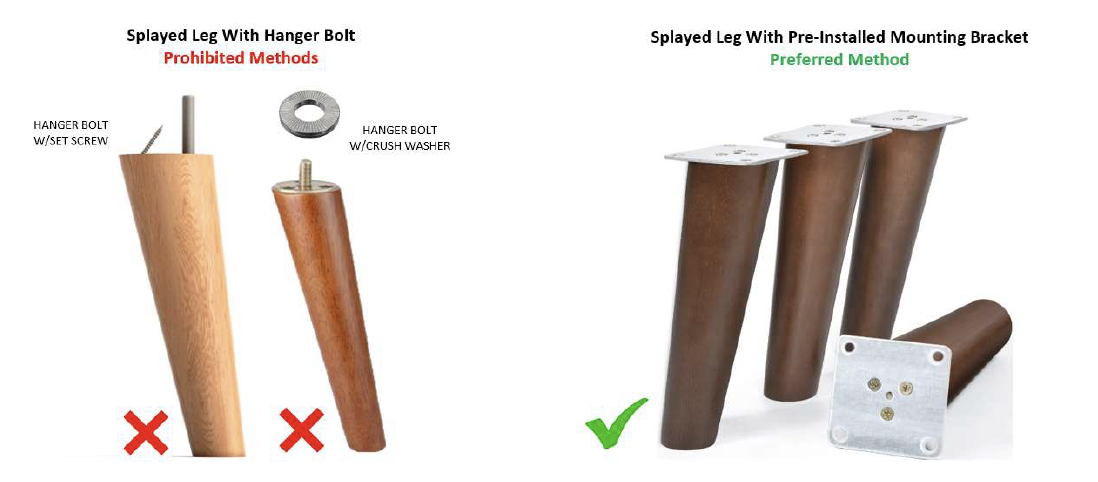Living Room Motion & Semi-Upholstery Standards
Master the TRUE FOB™ certified standards for motion furniture, power components, general tailoring, ottoman construction, and semi-upholstery methods.
🛋️ Motion Seating Foundations
Seating foundations for motion products must have webbing straps connecting the outer seat springs to the wood frame, ensuring durability without double-springing the ends.
⚙️ Motion Mechanisms
- Mechanisms must operate smoothly without noise.
- Springs require a foam insert to minimize noise.
- Manual actuator cables must be properly secured.
- Steel rails must use round mounting holes to prevent shifting.
- Backrest brackets must snap securely into place without shims or spacers.
🔌 Power Motion Components
- DC-powered systems only.
- Power receptacles must have a light (no switches).
- Cords must plug downward or sideways, with L-shaped plugs.
- Coiled and secured cables for modular sectionals.
- Pass-through cables for non-powered modular pieces.
- Control switches must have zippered arm access for repairs.
🎨 General Tailoring & Appearance
- Covers must be clean, uniform, free of stains or tears.
- Cushions properly sized without excessive gaps or overhang.
- Seams, welts, and nail head trims must be straight and even.
- No exposed staples or sharp points.
- Leather covers must be consistent panel-to-panel.
- Bottom dust covers must be strong and cleanly installed.
🪑 Ottoman Construction
- Ottomans must be structurally strong enough for seating.
- Storage ottomans must have air ventilation holes.
🛠️ Semi-Upholstery Standards
- Backrests: Use webbing or sinuous springs with proper tie wiring.
- Seating: No-sag sinuous springs spaced 4.5-5.5" apart, arched and double-sprung at ends.
- Cushion Cores: 1.8 lb/ft³ minimum density, wrapped, reversible if removable.
- Outside Panels: Must be padded to prevent frame feel-through.
- Legs: Prefer bolt-through metal-to-metal connection, properly labeled if shapes differ.
- Frames over 84" wide must have a center support leg.
🧵 Additional Upholstery & Leg Installation Standards
- Panel Padding(fig1): Outside panels must have cardboard + foam/fiber padding. Frame should not be felt through the cover.
- Arm Padding(fig2): Arms must be padded on inside, outside, and stump to prevent frame feel-through.
- Preferred Leg Installation(fig3): 4mm Allen bolt through leg into T-nut mounted in frame.
- Alternate Leg Installation(fig4): Hanger bolt pre-installed in leg screwing into T-nut.
- Prohibited Method: Wood screws permitted for promotional products only.
- Splayed Legs(fig5): Must use pre-installed mounting brackets. No hanger bolt-only legs.
- Stationary Leg Installation Holes(fig6): Leg holes must be clearly visible and not hidden under dust cover.
- Legs with Different Shapes/Sizes(fig7): Must be labeled for correct location during installation.
- Stationary Center Leg(fig8): Frames wider than 84" require a center leg, hidden from front view.
- Leg Pad Requirement(fig9): All wood legs must have a non-skid foam pad installed underneath.
fig 8
Units requiring multiple connections, such as dual and triple power units with motion headrests and lumbar support, should have large hangtags that alert the installer that additional connections must be made.
for Leather sofa and PU match, the green is PU and Blue is the Leather. proper placement
Dust cover = too many staples is bad.
fig 5
fig 9
fig 2
fig 4
fig6
fig7
fig 3
fig 1



























